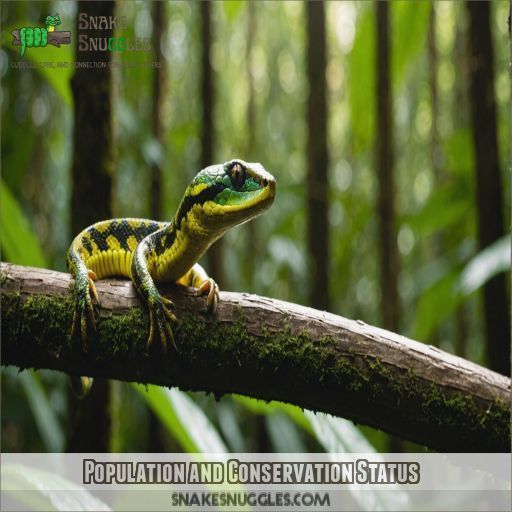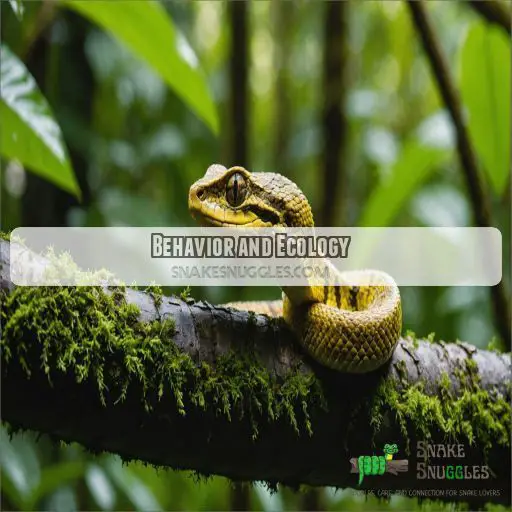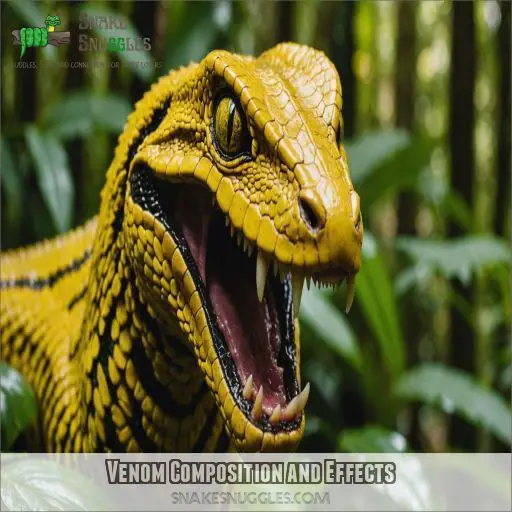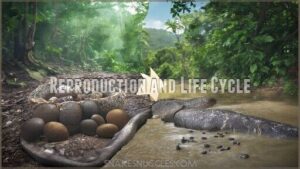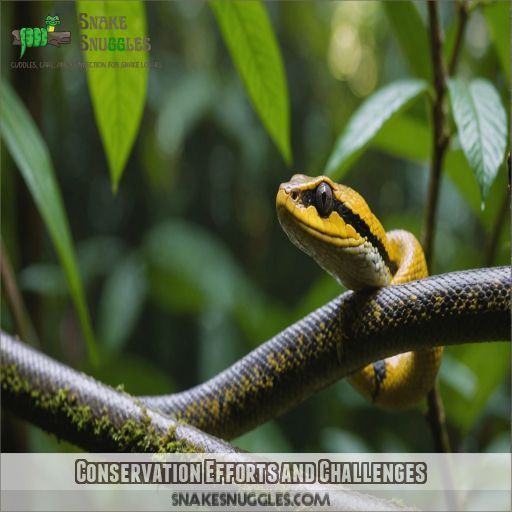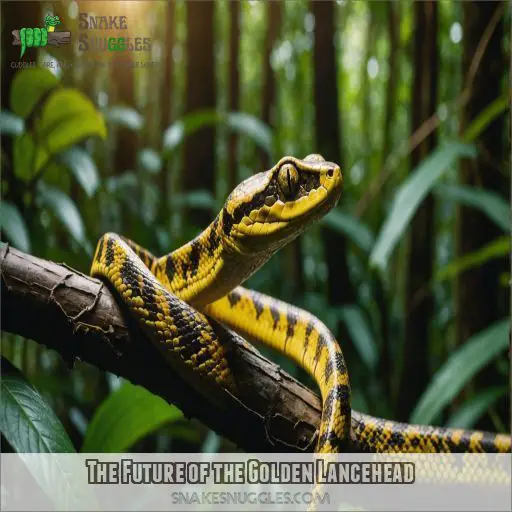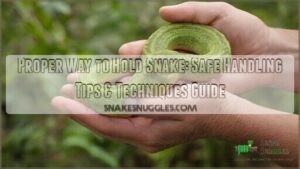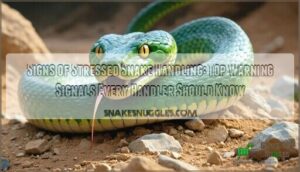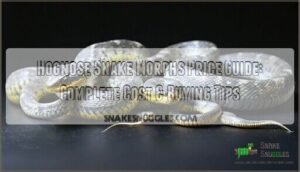This site is supported by our readers. We may earn a commission, at no cost to you, if you purchase through links.
 The Golden Lancehead (Bothrops insularis) is a venomous snake species endemic to Brazil’s Snake Island.
The Golden Lancehead (Bothrops insularis) is a venomous snake species endemic to Brazil’s Snake Island.
Its bite is five times more potent than its mainland cousins, making it one of the deadliest snakes in the world.
With a length of up to 75 cm, these vipers sport a yellowish-brown body with bold blotches, providing camouflage in their forest habitat.
Their venom contains a deadly mix of hemotoxins and neurotoxins, causing tissue damage, bleeding, and paralysis.
Despite their reputation, no fatal human bites have been officially recorded.
The golden lancehead is critically endangered, and its protection is vital for both medical advancements and ecological balance.
Table Of Contents
- Key Takeaways
- The Golden Lancehead: a Venomous Treasure
- Importance of the Golden Lancehead Snake
- Threats to the Golden Lancehead
- Diet of the Golden Lancehead
- Population and Conservation Status
- Behavior and Ecology
- Venom Composition and Effects
- Reproduction and Life Cycle
- Conservation Efforts and Challenges
- The Future of the Golden Lancehead
- Frequently Asked Questions (FAQs)
- What happens when you get bit by a golden lancehead?
- How much is a golden lancehead worth?
- Are golden lancehead vipers aggressive?
- Is it illegal to go to Snake Island?
- How dangerous is the golden lanceheads venom?
- What do golden lanceheads eat?
- Are there any golden lanceheads in captivity?
- How many golden lanceheads are left?
- Whats being done to protect them?
- Conclusion
Key Takeaways
- The golden lancehead is one of the world’s most venomous snakes, with a bite five times more potent than its mainland cousins.
- Its venom is a deadly mix of hemotoxins and neurotoxins, causing tissue damage, internal bleeding, and paralysis.
- This critically endangered species is found only on Snake Island off the coast of Brazil, and its protection is vital for medical advancements and ecological balance.
- Despite their deadly reputation, there are no official records of fatal human bites from golden lanceheads.
The Golden Lancehead: a Venomous Treasure
Take a closer look at the golden lancehead, one of the most venomous vipers in the world. Lurking in the forests of Brazil’s remote Snake Island, this snake packs a lethal punch – its venom is five times more potent than its mainland cousin.
Taxonomy
The golden lancehead, scientifically known as Bothrops insularis, is a venomous pit viper endemic to the remote Ilha da Queimada Grande in Brazil. This distinct species evolved from its mainland cousin, the fearsome Bothrops jararaca, over thousands of years.
- Phylogenetic relationships
- Evolutionary history
- Species classification
- Genetic diversity
[/OUTPUT]
Habitat and Location
Tucked away on Brazil’s Ilha da Queimada Grande, the golden lancehead has found its isolated island home – a unique ecosystem shaped by the region’s climate and limited resources. But threats loom, as habitat destruction edges ever closer to this remote snake’s domain.
Physical Characteristics
The golden lancehead’s distinctive features are hard to miss. Its pale yellowish-brown body is marked with bold, geometric dorsal blotches, and its long tail is an adaptation for moving through the island’s dense forest habitat. Prepare to be mesmerized by this venomous viper’s beauty.
- Striking Coloration
- Prominent Head Shape
- Elongated Tail
Venom and Bite
The golden lancehead’s venom packs a powerful punch, up to 5 times more potent than its mainland cousin. A bite can cause tissue damage, bleeding, and paralysis – a real medical emergency requiring swift treatment. But don’t worry, with the right precautions you can safely admire this venomous treasure.
Importance of the Golden Lancehead Snake
The golden lancehead viper is more than just a venomous snake – its venom has been instrumental in developing life-saving medications and is a valuable resource for scientific research. Despite its deadly reputation, this critically endangered species is a true treasure trove, with its conservation essential for both medical advances and ecological balance.
Medical Applications
The golden lancehead’s venom is a potent medical treasure. Its key ingredient, captopril, treats over 40 million people worldwide. This FDA-approved drug paved the way for innovative venom-based medicines. Imagine the lifesaving potential if we can discover more of this snake’s venomous secrets!
- Captopril – a venom-derived drug treating hypertension in millions
- Antihypertensive properties of lancehead venom compounds
- Exploring venom compounds for future cardiovascular medications
- Venom’s promise in developing novel pain management therapies
Scientific Research
Scientists are intrigued by the Golden Lancehead’s venom, studying its unique properties to develop groundbreaking medications. By unraveling the snake’s evolutionary adaptations, they hope to figure out the secrets of its potent toxins and harness their power for the greater good. The possibilities are as thrilling as they’re mysterious.
Conservation Efforts
Saving the golden lancehead from extinction is really important. Protecting the island, stopping poaching, and breeding snakes in captivity could all help this unique species survive. But funding and public cooperation are major challenges. A long-term, community-driven strategy is needed to safeguard this venomous treasure.
Threats to the Golden Lancehead
The golden lancehead faces numerous threats to its survival on Brazil’s Snake Island, a deadly habitat. Poaching for the lucrative black market and habitat degradation due to fires and vegetation clearing have severely impacted this critically endangered species.
Poaching
Poachers are a grave threat, stealing these rare serpents from their isolated home for black market profit. But ethical concerns and conservation efforts aim to curb this illicit trade and protect this venomous treasure of Brazil’s Snake Island.
Habitat Degradation
Habitat degradation on Ilha da Queimada Grande threatens the golden lancehead‘s survival. Intentional fires, vegetation clearing, and tourism pressure chip away at this snake’s precious island home in Brazil’s tropical moist forests. Protecting its fragile habitat is critical for this island endemic’s future.
Habitat Destruction on Mainland Brazil
Deforestation on Brazil’s mainland jeopardizes the golden lancehead‘s survival, disrupting the migratory bird prey it depends on. As habitats vanish, the snake’s fragmented populations face an ever-increasing risk of extinction. Conservation efforts must prioritize protecting this precious species.
Vegetation Clearing
The golden lancehead faces a troubling threat – the Brazilian Navy‘s vegetation clearing around the island’s lighthouse. This disrupts the delicate island ecosystem, impacting migratory bird populations and the snake’s dietary staples. Protecting this natural habitat is absolutely vital for the snake’s survival.
Diet of the Golden Lancehead
As one of the top predators on Ilha da Queimada Grande, the golden lancehead has developed a diverse diet to survive on the limited resources of this remote island.
The golden lancehead feeds primarily on birds, lizards, and even fellow snakes.
This venomous viper has honed its skills as a stealthy hunter, lying in wait to ambush unsuspecting prey in the island’s lush canopy.
Prey Species
As a primarily carnivorous creature, the golden lancehead snake‘s diet consists primarily of perching birds, including the southern house wren and various flycatcher species.
But don’t be fooled – these slithery predators also enjoy the occasional lizard, insect, spider, and even amphibian snack!
With the island’s limited food resources, these snakes must compete fiercely for their next meal, showcasing their remarkable adaptations and hunting prowess.
Hunting Strategies
The golden lancehead has honed its hunting strategies to thrive on the isolated Snake Island.
These venomous vipers ambush their prey, whether birds perched in trees or lizards scurrying across the forest floor.
Their lightning-fast strikes inject a venom potent enough to subdue even larger targets.
Adept at moving through the trees, these snakes patiently wait for the perfect moment to strike, showcasing their incredible adaptability to the island’s limited resources.
With their hunting prowess, the golden lanceheads maintain a delicate balance on this remote, endangered paradise.
Population and Conservation Status
The future of the golden lancehead viper hangs in the balance, as this critically endangered species struggles to survive on a tiny island. With population estimates ranging from 2,000 to 4,000 individuals, conservationists face an uphill battle to protect this venomous treasure from threats like habitat destruction and poaching.
Population Estimates
The exact population size of the golden lancehead is unknown, but estimates range from 2,000 to 4,000 individuals. Sadly, the population has declined nearly 50% in just 15 years due to habitat destruction and poaching. Conserving this exquisite serpent will require creative solutions to protect its tiny island home.
IUCN Red List Status
Great news, the IUCN has officially classified the golden lancehead as Critically Endangered, shining a spotlight on its dire plight. While their population may be dwindling, hope remains – with concerted conservation efforts, we can protect this venomous treasure and preserve its rightful place in Brazil’s biodiversity.
Conservation Challenges
The golden lancehead faces a treacherous trio of threats – habitat loss, poaching, and an ever-shrinking island home. Protecting this incredible species demands vigilant wildlife management, targeted conservation programs, and a steadfast commitment to protecting its fragile, irreplaceable ecosystem. Together, we can help this venomous treasure thrive.
Behavior and Ecology
The golden lancehead has adapted to life in the trees, using its long tail to maneuver through the dense foliage as it hunts for its preferred prey of birds and small lizards. Intense competition over limited resources on the tiny island fuels territorial disputes and aggressive behavior between these venomous vipers.
Arboreal Adaptation
The golden lancehead’s longer tail and flexible body allow it to expertly move through the island’s dense forest canopy. Its tree-climbing skills and branch-blending camouflage help it ambush unsuspecting bird and lizard prey. Adapting to this arboreal lifestyle is key to the snake’s survival on its isolated home.
| Adaptation | Purpose |
|---|---|
| Longer Tail | Improved Maneuverability |
| Flexible Body | Moving Through Branches |
| Camouflage | Blending with Foliage |
| Arboreal Hunting | Accessing Canopy Prey |
Predators and Prey
On Brazil’s Snake Island, the golden lancehead reigns as a fearsome hunter. This pit viper specializes in birds, lizards, and even smaller snakes – using its lightning-fast strike to subdue prey. But don’t feel too bad for its victims – this snake’s gotta eat to survive the island’s harsh realities!
Intraspecific Competition
The isolated habitat of Ilha da Queimada Grande intensifies competition among golden lanceheads for limited resources. These venomous vipers fiercely defend their territories, vying for mates and prey. Survival of the fittest reigns supreme on this island, shaping their behavior and social dynamics. Can conservation efforts overcome their primal drive to thrive?
- Resource scarcity fuels intense intraspecific competition
- Mating success depends on effective territory defense
- Prey availability dictates survival rates and population growth
- Conservation initiatives must address these behavioral challenges
[/OUTPUT]
Venom Composition and Effects
You won’t want to underestimate the golden lancehead’s deadly venom – it packs a punch, being five times more potent than its mainland cousin. This fast-acting cocktail can cause tissue destruction, bleeding, and even paralysis, though fortunately no fatal human bites have been documented.
Venom Potency
The Golden Lancehead’s venom is legendary, packing a punch five times stronger than its mainland cousin, the Bothrops jararaca. This lightning-fast, highly-evolved cocktail is a double-edged sword – both a medical marvel and a deadly threat. Check out the venom stats in the table below.
| Venom Property | Comparison |
|---|---|
| Potency | 5x more potent than B. jararaca |
| Onset | Rapid, acting in minutes |
| Components | Hemotoxic and neurotoxic compounds |
| Milking Yield | Sufficient for 40-80 doses of antivenin |
[/OUTPUT]
Hemotoxic and Neurotoxic Effects
The golden lancehead’s venom packs a one-two punch. Its hemotoxins destroy red blood cells, while neurotoxins paralyze muscles, making breathing difficult. This deadly cocktail can wreak havoc on the body, leading to tissue damage, internal bleeding, and respiratory failure. Antivenom is absolutely necessary, but time is of the essence.
Documented Human Envenomations
While no human bites have been officially recorded, legends persist. Tragically, three of four known envenomations were fatal according to snake expert Ludwig Trutnau. The effects can include:
- Brain hemorrhage
- Kidney failure
- Severe tissue necrosis
[/OUTPUT]
Reproduction and Life Cycle
Let’s shift our focus to the reproduction and life cycle of these fascinating vipers. Understanding how these snakes reproduce and develop is really important for their conservation.
Mating and Gestation
| Phase | Description | Duration |
|---|---|---|
| Mating | Elaborate rituals | N/A |
| Gestation | Carrying fertilized eggs | Months |
| Clutch Size | Typically 6 eggs | N/A |
| Birth | Live young | N/A |
| Parental Care | None | N/A |
Lifespan and Growth
Now, let’s talk about the longevity and development of these fascinating snakes.
In the wild, Golden Lanceheads have an average lifespan of around 10 to 15 years.
They reach sexual maturity at around 3 to 4 years old, and females typically give birth to up to 10 live young, which are independent from birth.
This species exhibits a relatively slow growth rate, taking several years to reach full adulthood.
Sexual Dimorphism
You’re curious about the Golden Lancehead’s romantic life. Well, in terms of sexual dimorphism, these snakes have slight differences in size and color. Males tend to be smaller and have a more vibrant yellowish-brown color, while females are larger with a duller tone. This subtle distinction is key to their reproduction cycle.
Conservation Efforts and Challenges
The future of the Golden Lancehead, a venomous treasure unique to Brazil’s Snake Island, hangs in the balance. Conservation efforts focus on habitat protection, artificial insemination research, and anti-poaching measures to safeguard this critically endangered species from extinction.
Habitat Protection
As you learn about the Golden Lancehead’s conservation efforts, it’s clear that habitat protection is super important. Ilha da Queimada Grande, their island home, faces threats from deforestation and degradation. Preserving the ecosystem is key to saving these venomous vipers. You can make a difference by supporting conservation initiatives and spreading awareness about the importance of habitat preservation.
Artificial Insemination
You’re now considering artificial insemination as a means to conserve the Golden Lancehead. Sperm collection is a delicate process, with a success rate that’s still uncertain. Future applications look promising, but there are ethical implications to weigh. Alternatives, like captive breeding, are also being explored to keep the species alive.
Anti-Poaching Measures
To curb poaching, a multi-pronged approach is key. This includes beefed-up law enforcement patrols, community outreach programs that raise awareness about the snakes’ importance, and financial incentives to encourage locals to protect, not poach. Working together with other countries is also absolutely necessary to stop the black market trade of these venomous vipers.
The Future of the Golden Lancehead
The future of the Golden Lancehead is a tricky one. With threats like poaching, habitat degradation, and a small, sensitive population, this snake’s survival is a delicate balance. Conservation efforts are key to protecting this venomous treasure, ensuring its survival and maintaining the species’ unique medical benefits.
Threats to Survival
The future of the Golden Lancehead is murky, with threats like inbreeding, climate change, and invasive species looming. Inbreeding is a big issue due to their small population, leading to health issues and reduced adaptability. Climate change impacts prey availability, and invasive species compete for resources. Add tourism and disease outbreaks to the mix, and these vipers need our help.
Conservation Priorities
The future of the Golden Lancehead depends on a few key factors. Here’s what needs to happen to help them survive:
- Habitat protection: Protecting their natural habitat is key. This includes preventing fires, stopping any further destruction, and restoring degraded areas.
- Poaching prevention: Stopping poachers is vital. Increased security and collaboration between conservationists, law enforcement, and local communities can help keep these snakes safe.
- Research and funding: More research funding means a better understanding of this species, which leads to more effective conservation strategies.
- Collaboration: Working together with local communities, scientists, and conservation organizations is essential for successful long-term conservation.
Potential for Recovery
The future of the Golden Lancehead depends on a few key factors.
Captive breeding programs can boost numbers and genetic diversity, but they’re tricky and still in the works.
Restoring their island habitat is a must, and keeping poachers at bay will give these vipers room to breathe.
Funding is always a challenge, but with the right support, this snake’s got a fighting chance.
Frequently Asked Questions (FAQs)
What happens when you get bit by a golden lancehead?
You’re facing a fight for your life. This snake’s bite packs a punch with severe consequences: swelling, pain, nausea, and a deadly cocktail of internal bleeding and organ failure.
How much is a golden lancehead worth?
The black market value of a golden lancehead viper can be anywhere from $10,000 to $30, This high price tag has led to illegal poaching and smuggling of these endangered snakes.
Are golden lancehead vipers aggressive?
The golden lancehead viper, a symbol of power and danger, is surprisingly calm, despite its reputation. Biologist Selma Almeida finds them a breeze to work with compared to other snakes.
Is it illegal to go to Snake Island?
Yes, it’s illegal to set foot on Snake Island. The Brazilian navy enforces a no-go zone around it. Only scientists are occasionally allowed, and even they face restrictions.
How dangerous is the golden lanceheads venom?
Imagine a lightning bolt striking you with the force of a thousand volts—that’s what facing the golden lancehead‘s venom feels like. This snake’s venom is a powerful cocktail of toxins, causing swelling, pain, nausea, and even kidney failure.
What do golden lanceheads eat?
These vipers have a taste for birds, especially perching birds like the southern house wren. They also feast on lizards, insects, and even their fellow snakes. Newborns stick to a diet of invertebrates.
Are there any golden lanceheads in captivity?
You’re in for a treat, as this one’s a real snake in the grass. Yes, there are golden lanceheads in captivity, but it’s a rare sight. They’re elusive in the wild and face a tricky road to successful captive breeding.
How many golden lanceheads are left?
Estimates put the golden lancehead population at between 2,000 and 4,000 individuals. This small number makes them critically endangered and very sensitive to any environmental changes.
Whats being done to protect them?
The future’s uncertain for these venomous vipers. Conservation efforts focus on habitat protection and stopping poaching. Artificial insemination research could also be a lifeline, but it’s tricky.
Conclusion
So, there you have it—the golden lancehead, a snake with a deadly reputation, is more than just a venomous threat.
Its bite might be nasty, but this snake is a treasure trove of medical potential and an important part of Brazil’s ecological puzzle.
These vipers are an endangered species, and their protection is key to figuring out future advancements.
We need to keep these snakes safe and learn from their deadly secrets.





